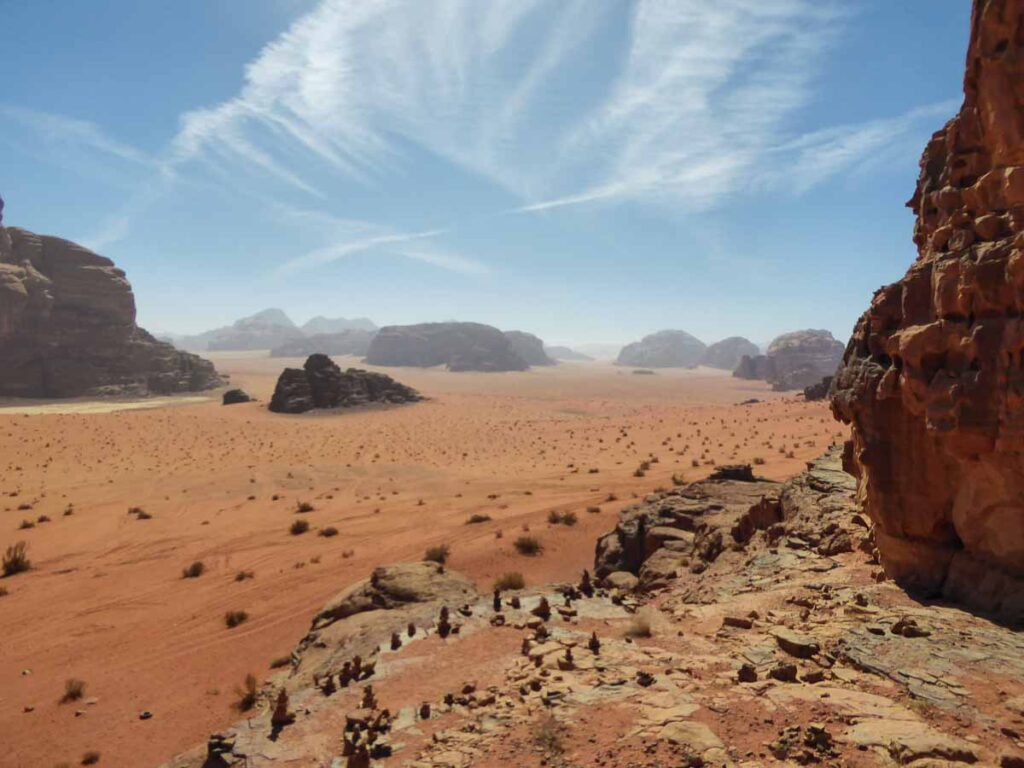Jordan is a wonderful country! Friendly people, delicious food and of course fantastic sights, like Petra and Wadi Rum.
Many people know these sights in Jordan from TV, Indiana Jones and Lawrence of Arabia are set here. But the country has much more to offer than that.
Most people only visit Jordan for a week. And you can actually see a lot in that short time because the distances are relatively short. However, I was in Jordan for 3 weeks and saw and experienced so much more and really don’t want to miss any of it.
Insider tip: Buy a Jordan Pass online before you leave! It will save you a lot of money in entrance and visa fees.
So, here are the 23 best places to visit in Jordan!
Amman
The Citadel
The Citadel stands on the highest hill in the city. From here you can literally get an overview of Amman. Take some time to familiarise yourself with the surrounding hills from up here. I found it easier to read the map after seeing the layout of the city from above.
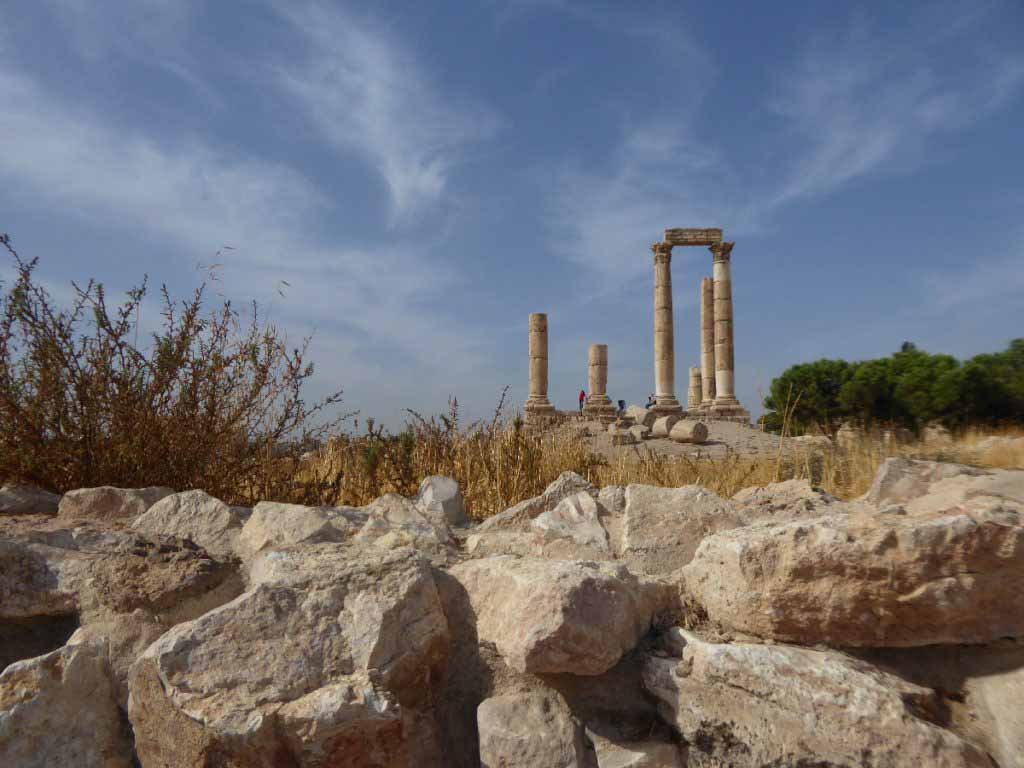
There are some impressive ruins up here, such as columns from ancient temples and the remains of a statue of Hercules. My favourite was the Ummayad Palace, or what is left of it. The ceiling of the dome is particularly impressive, so be sure to go inside.
The Archaeological Museum is also worth a visit, with the supposedly oldest human statues on display, and many everyday objects and trinkets dating back to the Bronze Age.
The Roman Theatre
An absolute highlight in Amman is the Roman theatre. It dates back to the 2nd century AD and can seat 6000 people. Seeing it in the middle of a city like Amman is pretty impressive. Take a seat and imagine what it must have been like 2000 years ago watching the actors with the citadel in the background.

Downtown
The city centre offers some small sights, some of them hidden. The Nymphaeum is worth a short visit, as is the food souk. Get lost in the chaos of fruit, vegetables, spices and meat, maybe buy some dates for a snack. Continue walking through the city centre, take a look at the King Husseiny Mosque and just stroll through the narrow alleys and the big main streets.
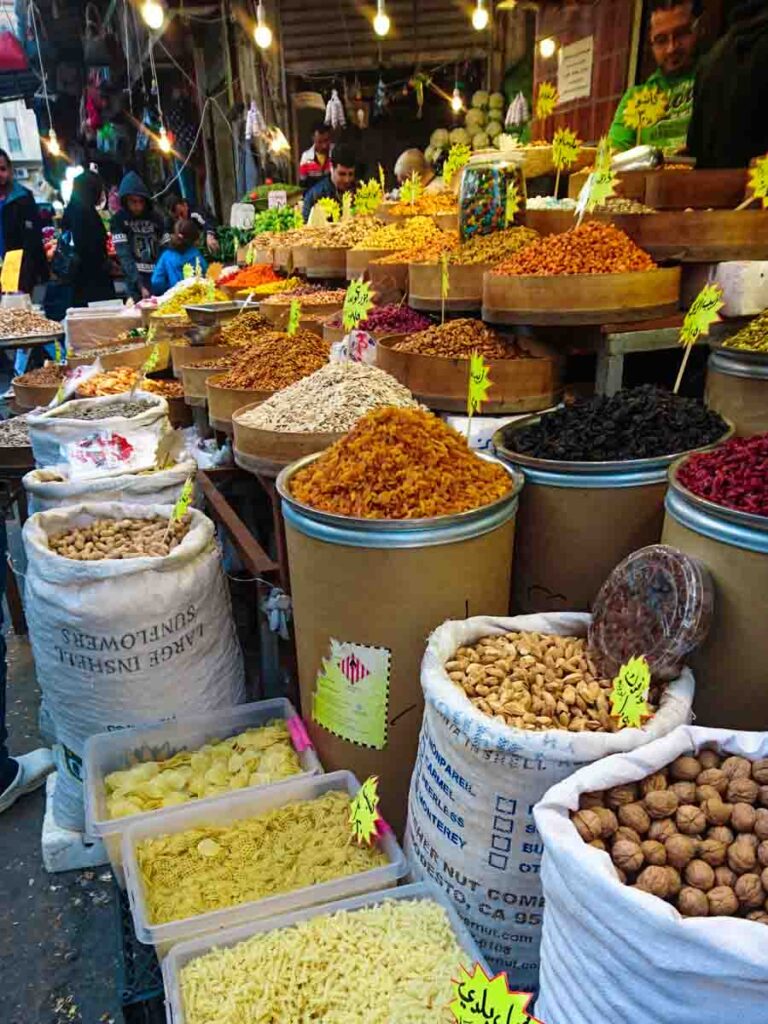
Jebel Amman
Jebel Amman is one of the 7 original hills of Amman. The street along the top is called Rainbow Street. It is full of small cafes and restaurants and there are many beautiful old houses in the adjacent streets. The Jordan River Foundation (art) and Wild Jordan (conservation) are located here.
Highlight/Insider Tip: Absolutely recommend a cooking class at Beit Sitti, my favourite activity of the whole trip!
For more food tips, check out my article on my favourite restaurants in Amman.
Jordan Museum
The Jordan Museum is relatively new and very modern. There is a permanent exhibition on historical and contemporary topics, including the famous Dead Sea Scrolls. When I was there, there was also an exhibition of inventions and discoveries by Arabs. It was very modern and multimedial and you can easily spend a few hours learning.
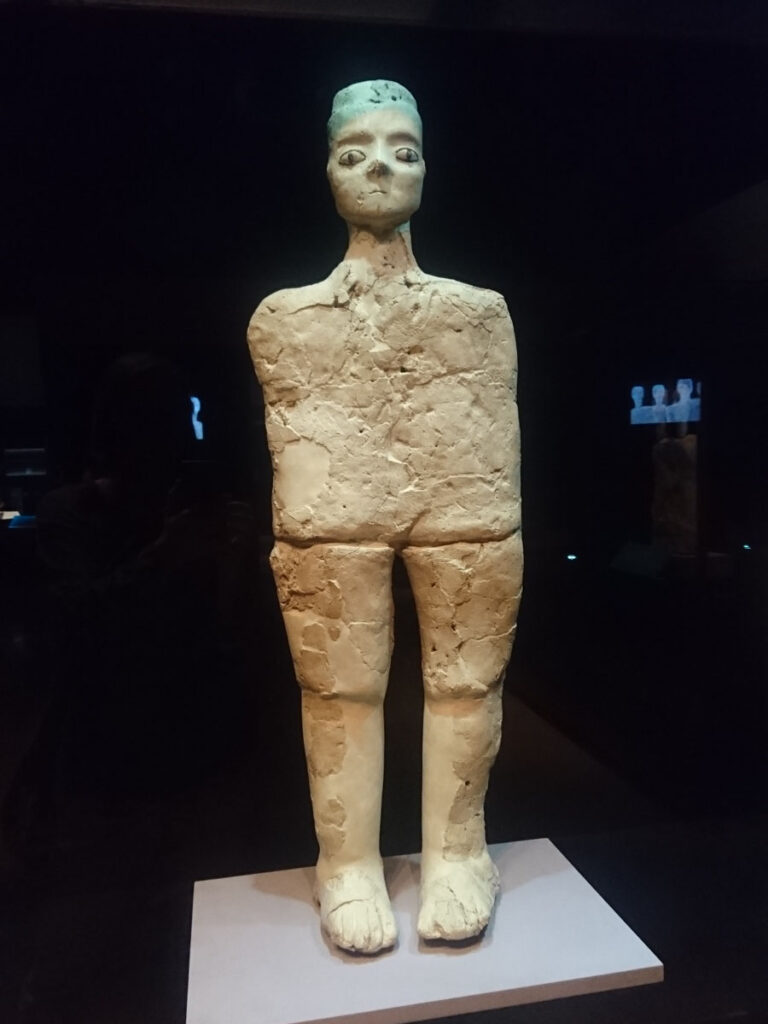
King Abdallah Mosque
To visit the blue King Abdallah Mosque, you should take a taxi. It is possible to go inside, but you have to respect the dress code.
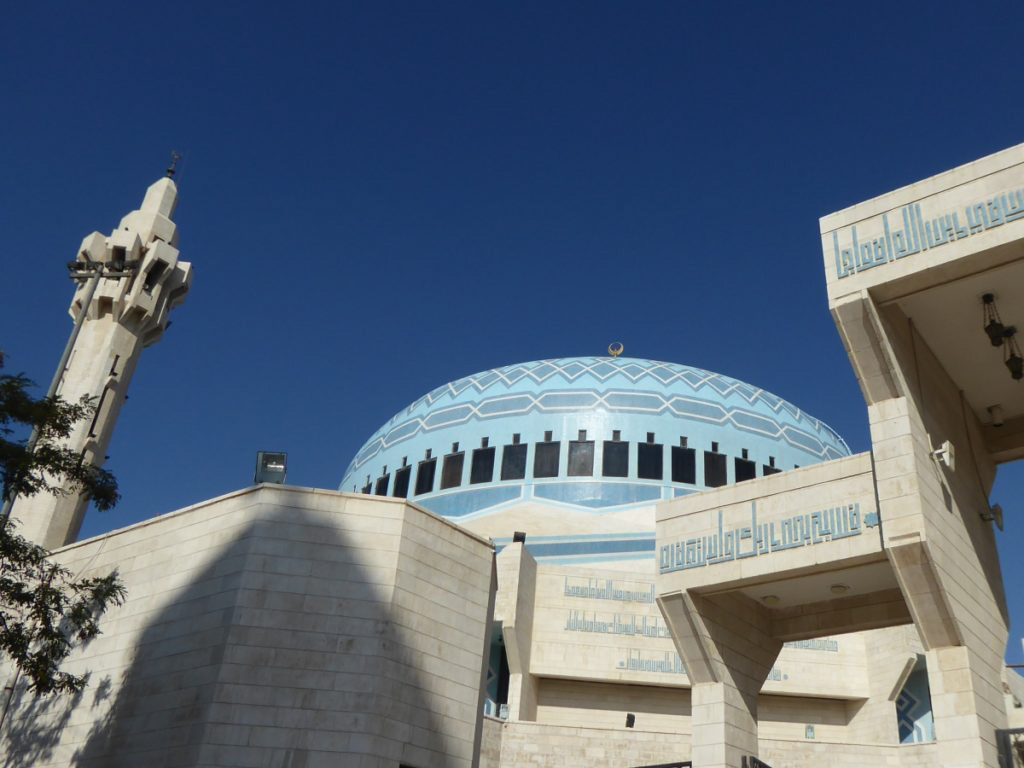
Tour tip: Private Sightseeing in Amman
Jordan’s sights in the south
Petra
Petra, the legendary city of the Nabataeans and the most famous of Jordan’s sights. Although, strictly speaking, it is only the burial place of the Nabataeans, it is still not clear where they actually lived. One theory is that there was a tent city for the people of Petra.

Built between 300 BC and 100 AD, the city was later also inhabited by the Romans, who built their own temples. In 363 AD, the inhabited part of Petra was destroyed by an earthquake and remained forgotten until the early 19th century.
Petra was my absolute highlight of the whole trip! I had wanted to go there since I was a child. I don’t know why I put it off for so long, but finally the time had come. To make sure I would see everything I wanted to and also experience Petra by night, I planned 3 days/4 nights. And I did not get bored! Here you can find a lot of information and tips for visiting Petra.
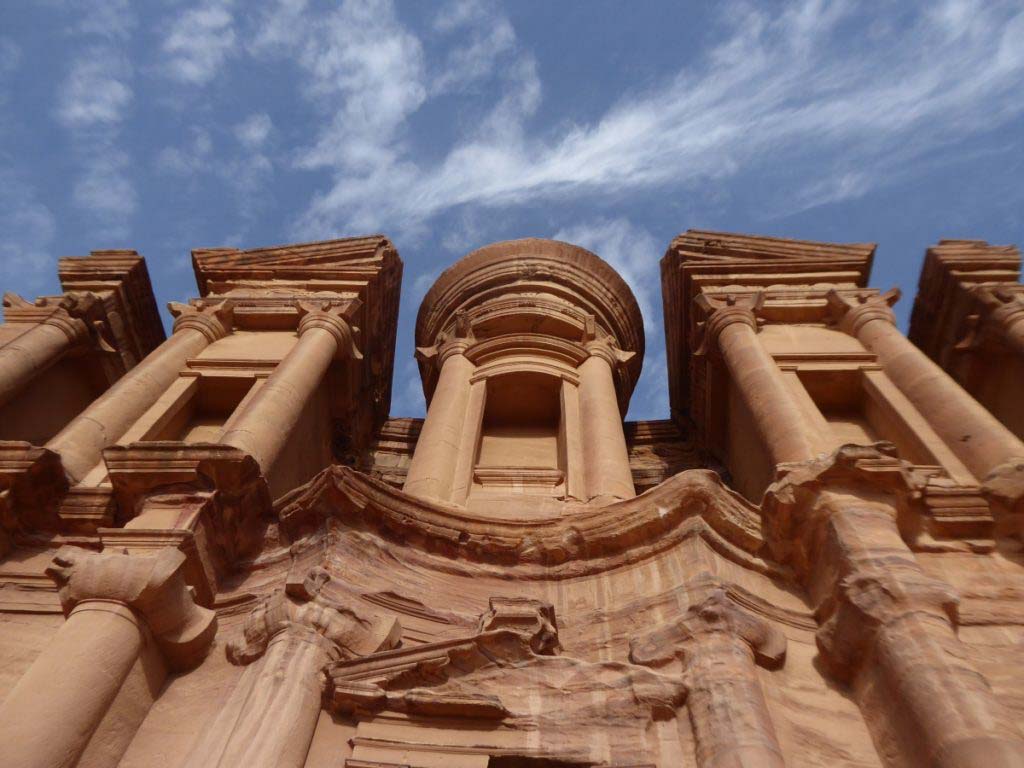
I walked to the High Place of Sacrifice, the Monastery (Ad Deir), the Al-Khubtha trail and everything in between. Of course, the Treasury (Al Khazane) is a highlight as it is the most famous building in Petra, but my favourite was the Monastery.
For more details on the hikes in Petra, check out this post.
You should definitely try to enter the site before the masses of day tourists. It’s best to arrive in Wadi Musa in the evening so you can get inside early in the morning.
Tour tips:
Wadi Rum
Almost everyone has seen Wadi Rum, as many films are shot here. The most famous are probably “Save Mark Watney” with Matt Damon and the classic “Lawrence of Arabia”.
For some reason, most people only seem to stay overnight in Wadi Rum. And they have no idea what they are missing! The sight of the sunsets alone is worth staying a few extra days (I was in Wadi Rum for 5 days in total).

On day 1, I took a jeep tour and checked out the typical tourist spots. A spring, a house where Lawrence of Arabia lived and a somewhat larger sand dune.
On the other days, I did 2 long hikes, up Jebel Hash and Jebel Umm Ad Dami, Jordan’s highest mountain. The views over the desert are fantastic and definitely worth the hike/climb. From the top of Jebel Umm Ad Dami you can also see the border with Saudi Arabia as it is only a few kilometres away.
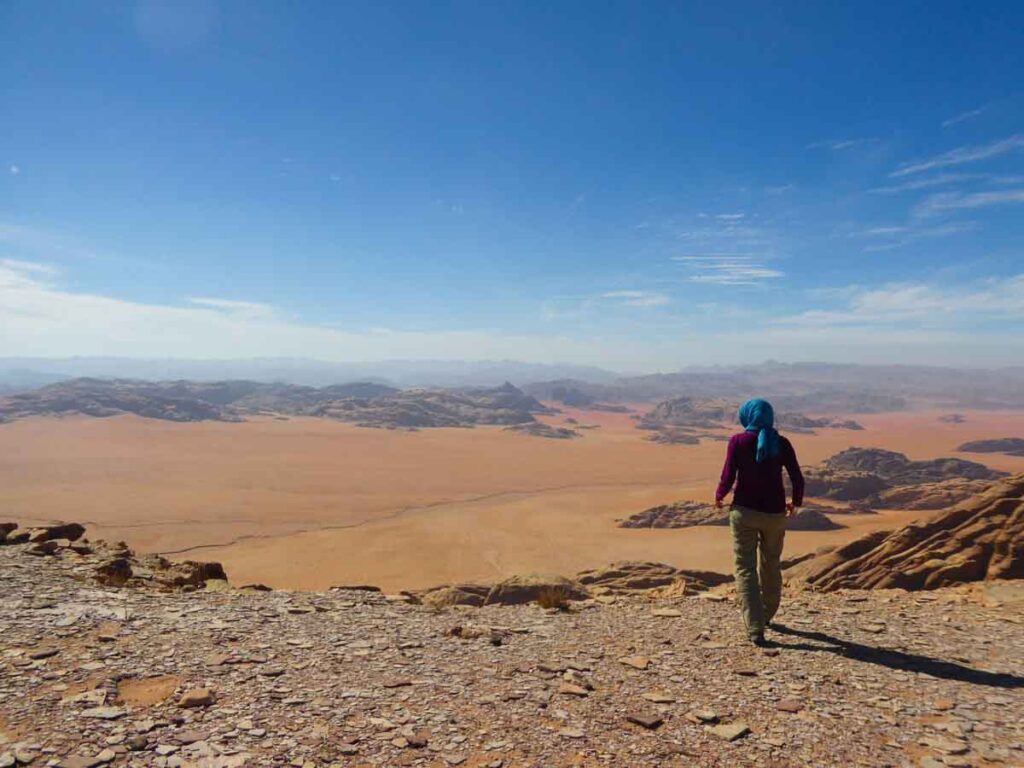
On the day between the hikes, I had booked a 6-hour camel ride. Luckily, I didn’t actually have to ride for 6 hours, but had tea, lunch, sightseeing and some climbing included.
The only downside of staying at the camp for 4 nights is that they prepare the same food every night. But as it’s really tasty, it wasn’t too bad.
As a side note, if you have a rental car, you have to leave it in the visitor car park and it will be picked up by staff from the camp you are staying at.
You can check out my full guide to Wadi Rum here.
Hotel tip: All camps offer activities as well, just contact them! Here you can find the best deals for camps in Wadi Rum
Aqaba
Aqaba and South Beach are an absolute diving and snorkelling paradise! The Red Sea here has some of the best diving I have ever seen. Whether you like diving and snorkelling or not, you’ll have a great time exploring Aqaba and going swimming at South Beach.
The coral and fish are plentiful and healthy, and there’s also the sunken wreck of a huge freighter, a tank and a recently sunk plane to see here.
Jordan’s sights in the north
Umm Qais
The Roman ruins of Umm Qais, also known as Gadara, date from the 3rd century BC to the 8th century AD, when an earthquake devastated the region.
Under the Romans, it was part of the Decapolis and was heavily developed and fortified to counter the Nabataean empire that built Petra.
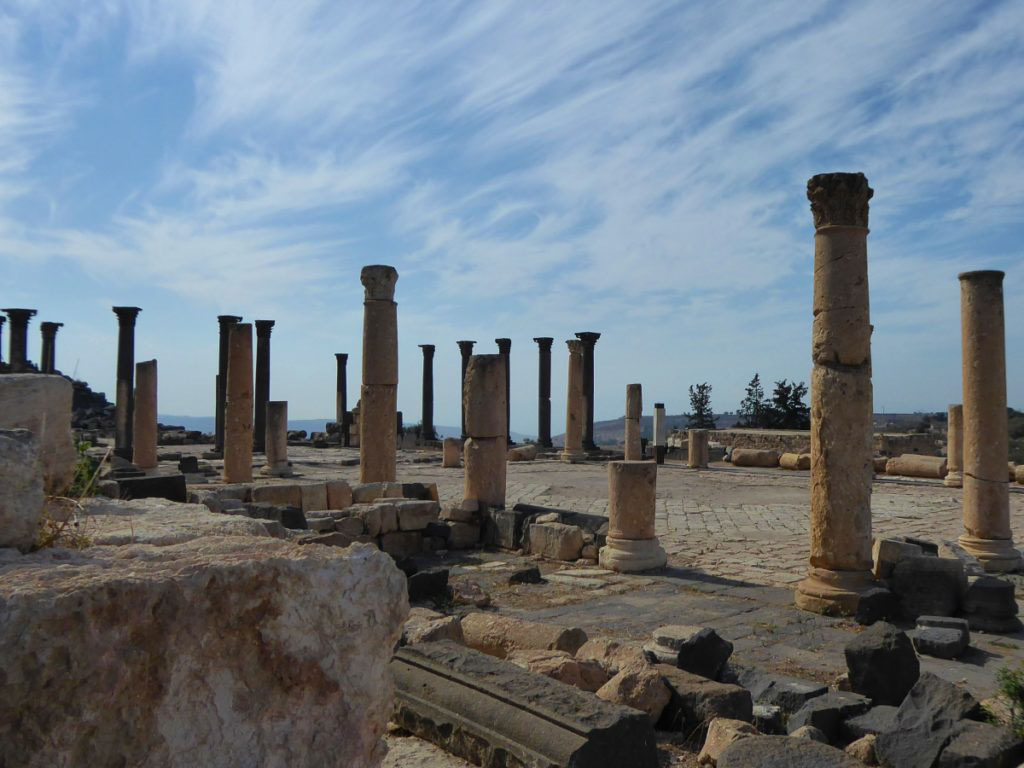
Today, many structures can still be easily recognised, on the main street you can even see the traces of the wheels of the old horse-drawn carriages. There are remains of several temples, a nymphaeum and 2 theatres. The site is quite extensive and you should plan a couple of hours to explore everything without stressing.
There is a viewpoint from which you can see the Sea of Galilee, the Golan Heights and parts of Syria. If the weather is good, you can supposedly even see as far as Lebanon.
Ajloun
The fortress of Ajloun dates back to the time of the Crusaders, but was built by their Jordanian enemies, allegedly commissioned by Saladin himself. It overlooks beautiful mountains and valleys and is definitely worth a visit.

Interestingly, the fortress was attacked and partially destroyed by the Mongols in 1260. It has been extended and rebuilt several times over the centuries, which can be seen in the walls and gates in many places.
Jerash
Jerash is one of my favourite places in Jordan! I was lucky enough to be there during a gorgeous sunset, but even without that perfect light, I would have loved it just as much. It is definitely one of the must-visit sites in Jordan and great for a day trip from Amman!
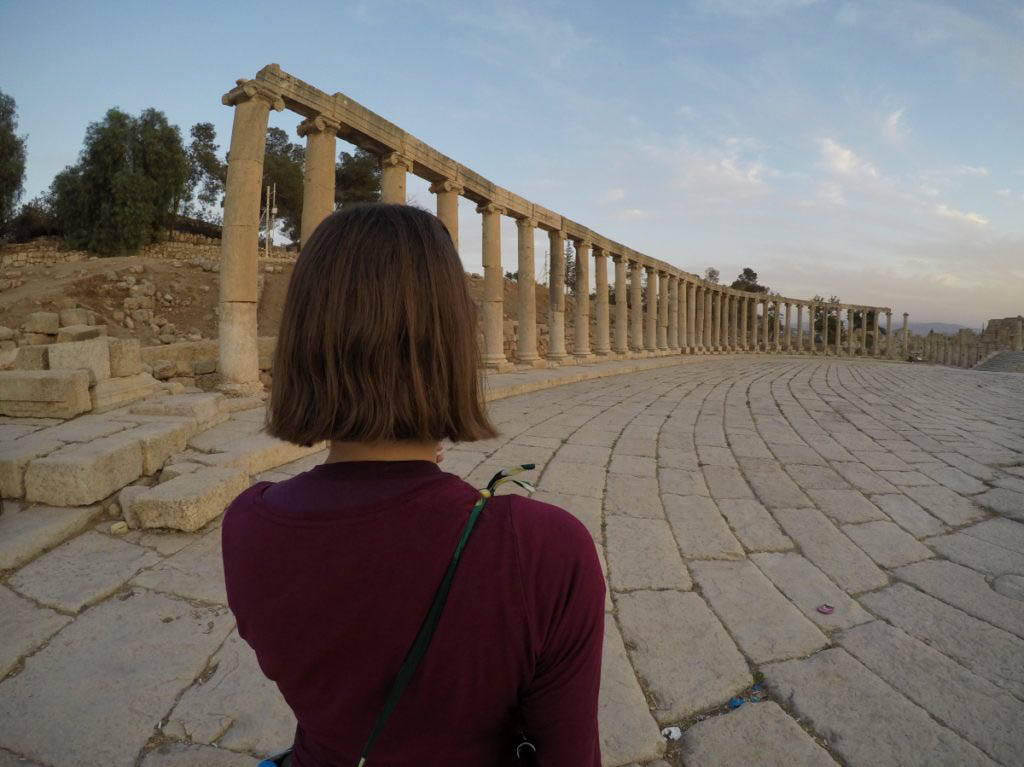
Jerash was also part of the Decapolis and from the 1st century AD. Chr. very prosperous. This is reflected in the many magnificent buildings, of which surprisingly much can still be seen.
Despite several earthquakes, many columns still stand on the great oval and along the main street.
You really get a feel for the city it once was, as many of the ruins are in good condition and the modern city was built across the river. The Nymphaeum and the Temple of Artemis are my favourite buildings. But the theatres and triumphal arches are also very impressive.

You should plan at least 2-3 hours here, especially if you like taking photos. The best light is in the late afternoon.
In summer, Jerash hosts a music festival here with many local but also international artists.
Tour tip: Private tour to Jerash and Ajloun
Places to visit in Jordan in the east
Desert castles
The desert castles are best visited as a day trip from Amman with a driver. The road to the east is used by many trucks on their way to Saudi Arabia and Iraq and their driving style takes some getting used to.
Why the buildings are called castles is a little unclear. In fact, only one is actually a fortress of sorts.
Qasair Amra
The Qasair Amra is a very beautiful building that was probably used as a kind of hunting lodge. There is a large hall with fantastic frescoes on the walls. Attached to it is a Roman bathhouse with wall paintings and probably the oldest image of the night sky with the constellations in a dome. It has been a UNESCO World Heritage Site since 1985.

There is a museum in the entrance area with some interesting information.
Qasr Kharaneh
The Qasr Kharaneh is most likely an old caravanserai for the traders who travelled on this route. It was built in the 7th century and has survived in relatively good condition. You can visit the rooms on 2 floors and marvel at the detailed decorations.
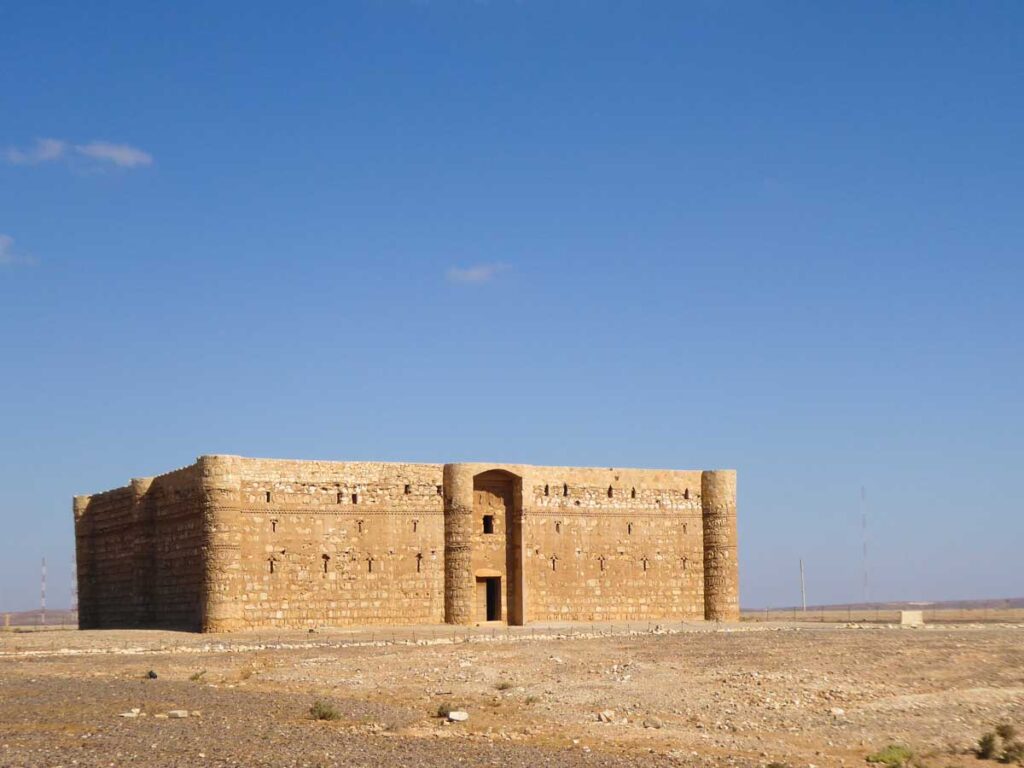
I tried to imagine what it must have been like to finally arrive here after days or weeks on camels through the desert. To sleep with a solid roof over your head. And to know that Amman is only a few days’ journey away.
Qasr Azraq
Azraq means blue in Arabic and refers to the oasis in the neighbourhood. The Qasr is an old Roman fort with interesting architecture. The arches that support the ceilings are all just stuck together without mortar or the like and have held for many centuries. In the centre of the courtyard there is a mosque, probably built by the Ummayads.
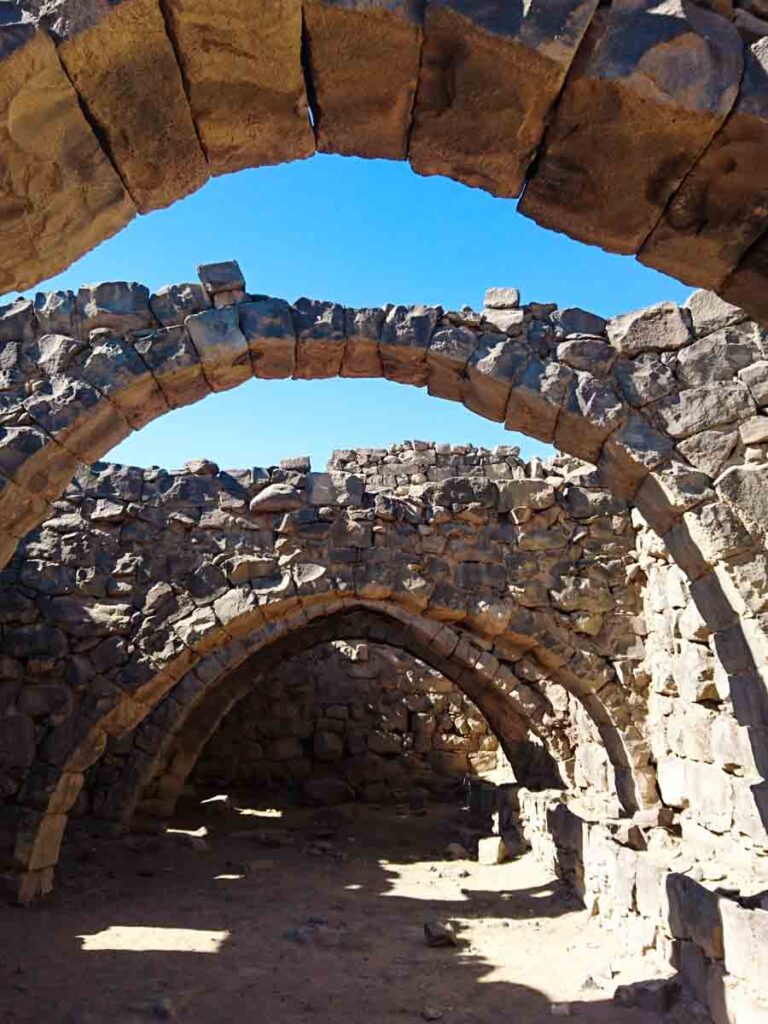
Also interesting, Lawrence of Arabia set up his headquarters here for a while.
Tour tip: Trip to the desert castles
Azraq Wetland Reserve
The Azraq Wetland Reserve is a conservation project with lots of birdwatching opportunities. And, if you are really lucky, you can also see water buffalo. It is an important project because in recent years more and more water is being transported from here to Amman and the oasis is slowly drying up.
Jordan’s must-see sights in the west
As Salt
Salt is a cute little town with a long history dating back to the Iron Age. Nowadays it is a very untouristy town with good museums and a nice heritage walk that takes you to the sights.

I really liked it here, unfortunately I didn’t have that much time as it was just a stop on the way to the Dead Sea. But I can well imagine spending a little longer here.
Mt. Nebo
Mt. Nebo is supposedly the place where Moses first saw the holy land and also where he died. There is a church with great mosaics and the view over the Jordan Valley is fantastic. For a more surreal experience, visit the La Storia Museum a little way down the road. They have dioramas showing daily life in Jordan from the past to the present.
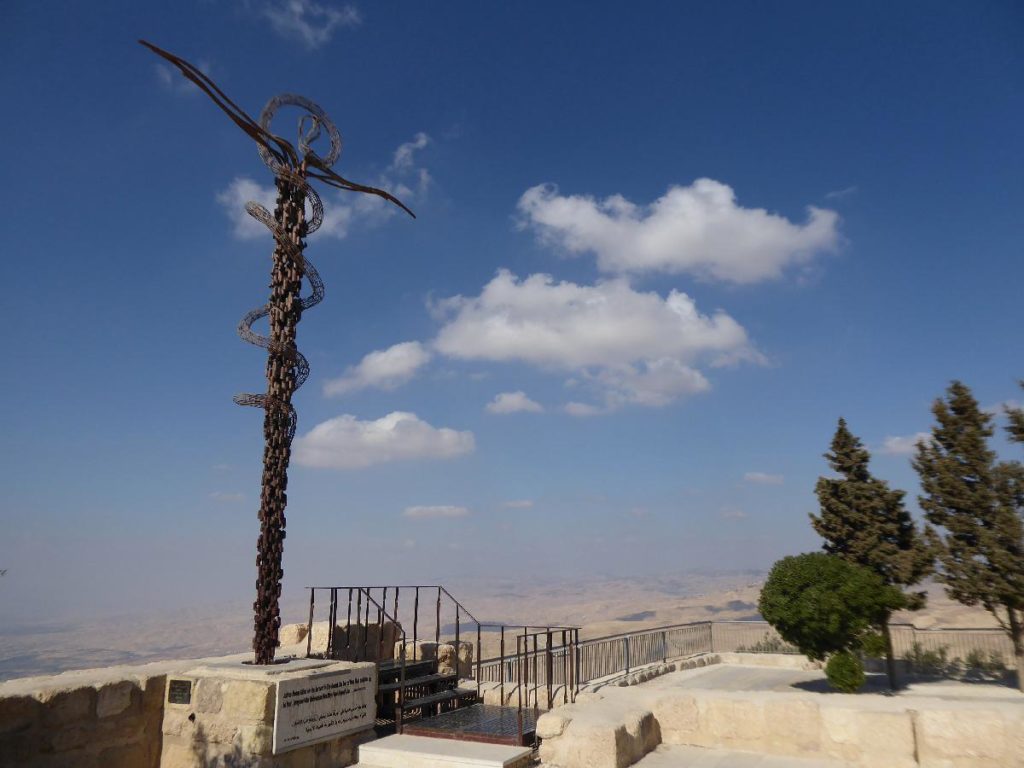
Madaba
Madaba is famous for its well-preserved mosaics, including the most famous, which shows a map of the Middle East from Lebanon to the Nile Delta and from the Mediterranean to the Eastern Desert. It can be admired in St. George’s Church.
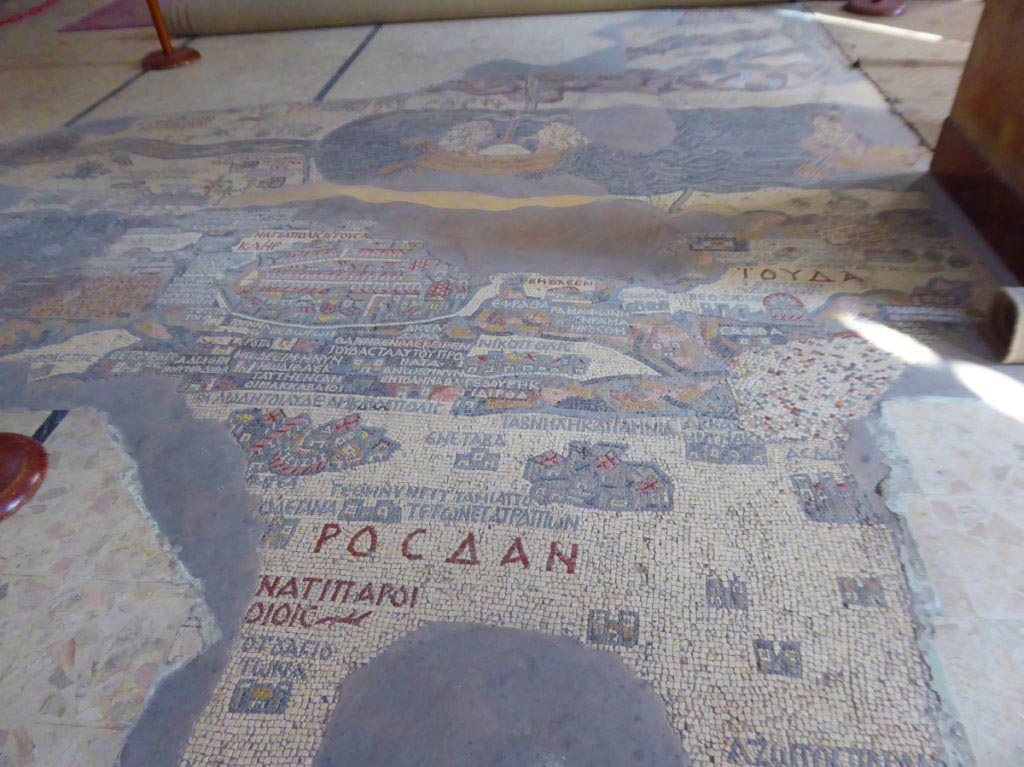
More mosaics can be found in the Madaba Archaeological Park, which is also well worth a visit.
But the city offers more than this. Madaba is small enough to just walk around and get a little lost. There are many small shops where you can buy some souvenirs, have a cup of tea and chat with the owners.
Restaurant tip: Haret Jdoudna in Madaba. It is a traditional Jordanian restaurant with fantastic food.
Insider tip: Spend the last day(s) in Jordan in Madaba and drive directly to the airport from here. The taxi ride from Madaba to the airport only takes about 30 minutes and should cost around 12 JD. The hotels in Madaba will happily book this for you.
Dead Sea
The Dead Sea sets records, the lowest point of the earth’s land mass and also one of the saltiest seas in the world.
Unfortunately, there are no public beaches here, so you either have to spend a night in one of the expensive luxury hotels, or buy a day pass.
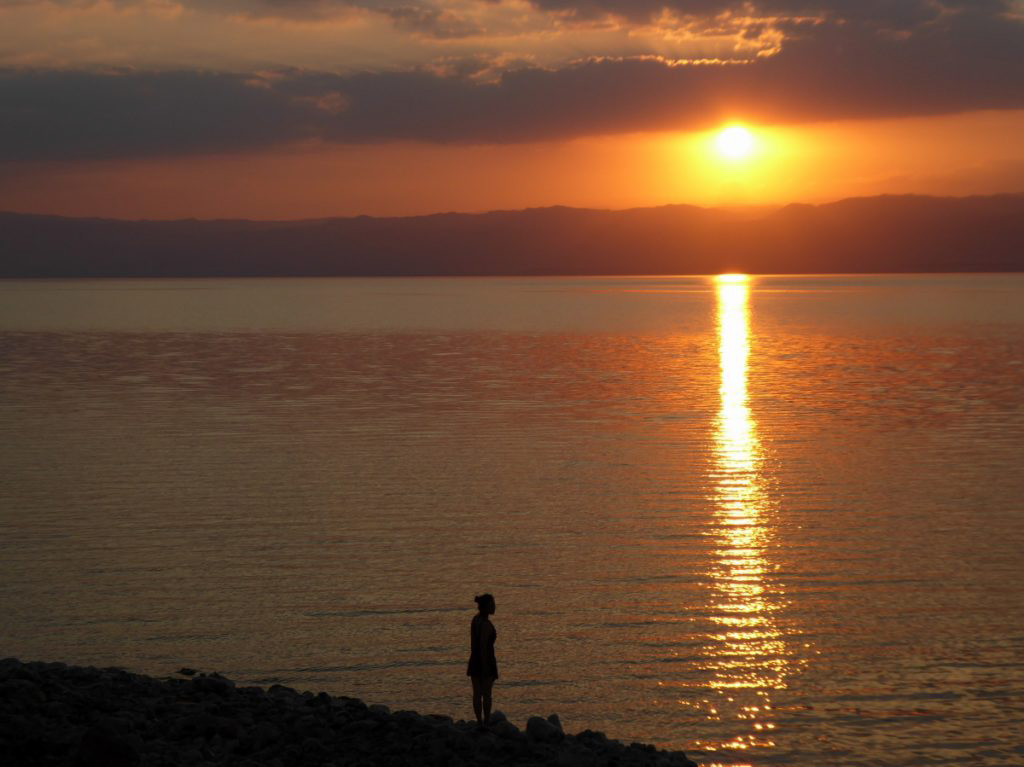
The experience of floating on the water like a balloon is quite interesting. But also, much more uncomfortable than one might think. After the bath, you can rub yourself with the black mud that the spas at home sell for expensive money. There are also showers on the beach to rinse it off again, but beware, salt water comes out here too.
Insider Tip: don’t shave for a few days beforehand. Otherwise, the salt will burn like fire!
If you like to spend a day by the pool, this is the place to do it. Otherwise, there is not much to do, so I would recommend a day pass.
Wadi Mujib
The Wadi Mujib is also called the Grand Canyon of Jordan. Included in the UNESCO Biosphere Reserves for 10 years, it offers unique flora and fauna. The best way to explore the wadi is with a canyoning adventure. However, these are only offered in the dry season, otherwise there is a risk of flash floods. A total of 7 tributaries from the surrounding mountains feed the Mujib River, which flows through a spectacular gorge into the Dead Sea.
Tour tip: Hiking in Wadi Mujib
Ma’in Hotsprings
The hot springs of Ma’in have become a tourist hotspot in recent years. Idyllically situated, here you can recover from the rigours of travel. There are several pools and a few small waterfalls. You can also stay overnight in the adjacent hotel.
Dana Biosphere Reserve
The Dana Biosphere Reserve is a huge nature reserve with great hiking opportunities. It is basically a huge canyon, with accommodation available at the top in Dana Village or at the bottom where the canyon merges into Wadi Araba.

There is a wide range of hiking trails, but most can only be found with a guide. It’s worth it, though, otherwise you’ll miss the many rare plants and animals that the landscape here has to offer.
Hotel tip: Feynan Eco Lodge
Of course, there is much more to see in Jordan, but I’ll have to go back myself for that!
You might also be interested in these posts:
Please note that some of the links above are affiliate links and, at no additional cost to you, I earn a small commission if you make a purchase. That income goes to supporting this website and keeping it free for you and everyone else!

